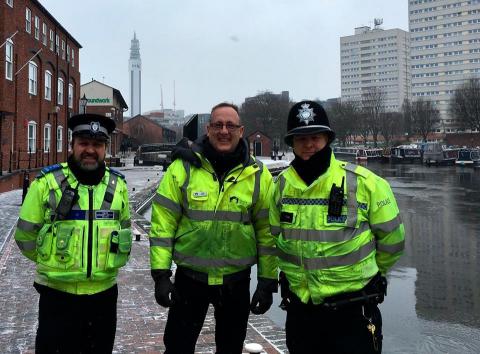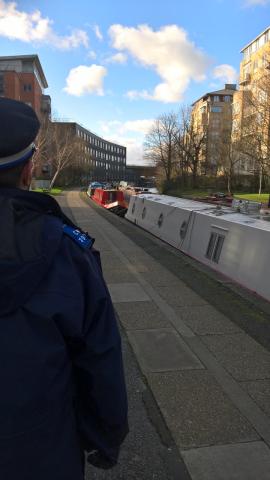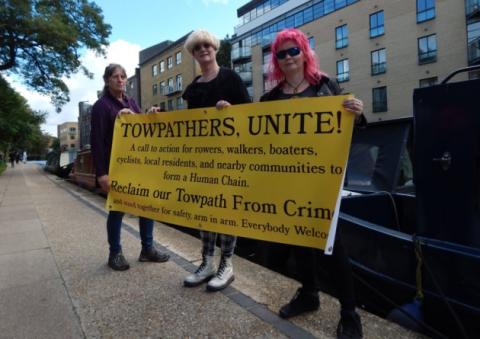Towpath crime rising?
March 2018 - Keeping both yourself and your boat safe from thieves, and worse, on the towpath is becoming more of a problem for boaters, especially in some of the less salubrious parts of London but also elsewhere, including some surprisingly rural spots, as Peter Underwood reports.
Set against a background of a government which has shrunk police budgets and reduced numbers over many years, it is unsurprising that boaters should become victims of the rising crime rate, alongside land dwellers.
In some places the presence of boats and boaters has helped in the past, reclaim the towpath from being a haunt of drug users and dealers and others seeking a quiet place for nefarious deeds; but such people haven't disappeared and in cities petty criminals driven out of gentrified areas find towpaths and vulnerable boats an easy target.
In London there have been several reports of boaters attacked or followed at night returning to their boat, there are almost daily warnings of suspicious individuals apparently 'casing' boats and weekly reports of break-ins.
Safety concerns have led to a mass event aimed at reclaiming the towpath last year and the imminent establishment of boater towpath patrols designed to deter robbers and violent attackers.
Security, both for a boat and an individual is problematic for boaters, especially those who don't have a home mooring and are regularly moving from one area to the next.
It is almost impossible to make many boats secure, short of welding bars across windows. When a thief can stand on the towpath and put a heel through a boat window, it doesn't matter what locks or bars are put on doors.
Equally boaters coming home from work or shopping in the winter to a mooring in an area they don't know well are often faced with dark towpaths, lonely and hidden places that can easily give shelter to muggers or even rapists.
Just how much worse it may be getting is difficult to pin down. The Metropolitan Police were asked whether they were aware of an increase in towpath crime and whether they had any specific initiatives to deal with it?
The response was swift but unenlightening: "With the extensive waterways in London, from rivers to canals covering multiple boroughs, there is no way we could ascertain this information.
"A robbery on a towpath, or the burglary of a houseboat, would only be classified as robbery or burglary, but they would not have searchable data indicating the offence was on or near a waterway."
Crimes in London rose by 34,000 between 2015-16 and 2016-17 although Assistant Commissioner Martin Hewitt, responsible for Territorial Policing, said: "London is one of the safest global cities in the world. There are few others with such low rates of serious crime, such as murder and gun crime.
"Similar to the rest of England and Wales, crime rates in London are rising, but many of these are still at a much lower level than five years ago and are against the backdrop of significant reductions in resources."
He went on: "We are concerned about the rise of gun crime and rise of knife crime offences committed by young people and the changing nature of the offenders. Young people carrying knives are doing so for a variety of reasons including status, criminality and self-protection but only around a quarter are affiliated with gangs."
If the Met isn't looking at towpath crime as an issue, boaters and Canal & River Trust are taking it more seriously. If the towpaths get a reputation as a crime hotspot it will seriously hamper C&RT efforts to portray it as a place that contributes to the 'wellbeing' of the wole population.
C&RT told The Floater: "Nationwide our teams work with local police forces as and when specific issues come up, including but not limited to: helping police identify particular crime hotspots; working with them in regards to stolen boats and break-ins; assisting where necessary to get witnesses and information.
"You may be aware of Canal Watch – we’ve teamed up with West Midlands Police to launch a neighbourhood watch scheme for the canals in the area. It’s something we’re going to be watching, with a view to introducing in other areas.
"In the capital, we’re working with police across London’s waterways, including Bow; Westbourne Park; Tower Hamlets; Homerton; Camden; and King’s Cross. We also attend the Safer Neighbourhood team meetings across the London network and do regular towpath walks to help the police to get to know the needs of the canals, and to get the boating community to talk to the police.
"We’re working with local boaters and the NBTA to create a canal watch scheme in the capital, and we support any workable initiatives from boaters or the wider public, such as the ‘reclaim the towpath’ event organised by the boating community last year.
C&RT is also anxious to identify towpath crime hotspots, saying: "One thing boaters should always do is, after they’ve reported an incident to the police, let the Trust know too. We can plot incidents onto our GIS (mapping) system – that way when we work with police we can show them where clusters of incidents occur."
C&RT is currently working with the Metropolitan Police in the Mile End, Hertford Union and Victoria Park area of East London where police action is being planned after a spate of crime. Police have asked boaters to report suspicious activity to either 101 or 999 for emergencies.
The Reclaim the Towpath event, creating human chain along the towpaths, primarily in East London has led to Canal Watch London, a small team of boaters that have been meeting with the Marine and local police, and the Jewish Shomrim, a volunteer policing scheme in some parts of London, to gather an understanding of how they can make the canals safer.
Organiser Jean said: "We will hold an event during the Easter holidays, where police officers and others will talk about ways to increase security on the towpath.
"We will be starting our nightly patrols of the Victoria Park and Hackney Wick area at this time too. We are currently trying to recruit boaters to make this initiative possible."
Yet this is not just a London problem as the Birmingham Canal Watch scheme shows - as do a number of boat break-ins along Grand Union, even close to the upmarket Grove Hotel outside Watford, on the rural Macclesfield and even around canal market towns like Stone and Market Drayton and even two or three boats stolen and sailed away most years.
There is countrywide concern amongst boaters about security but the core problem is that it is next to impossible to make a boat truly secure short of turning it into a sort of armoured vehicle.
Boats with portholes - small ones - and steel doors bow and stern with good locks are probably more secure than others from break-ins, if not from vandalism, but determined thieves, some carrying bolt croppers and even battery powered cutting tools will find a way in if the boat is unoccupied and away from prying eyes.
Boaters with windows, perhaps wooden doors, and just normal security are always going to be vulnerable to determined robbers. Equally boaters are more vulnerable to personal attacks as they are more likely to using towpaths at night, in winter and when there is no-one to come to their aid.
Cities have higher crime rates, but there may be partial solutions in places like London and Birmingham, with C&RT and boaters working with and bringing pressure on the police and boaters banding together to care for each other.
The hundreds of miles of rural towpath may be a more difficult proposition.
Photos: (1st) Canal Watch in Birmingham - C&RT and police at Cambrian Wharf in the snow, (2nd) Police patrols are being increased in some areas, (3rd) Reclaim the Towpath - a London protest which has developed into Boater Towpath patrols.








